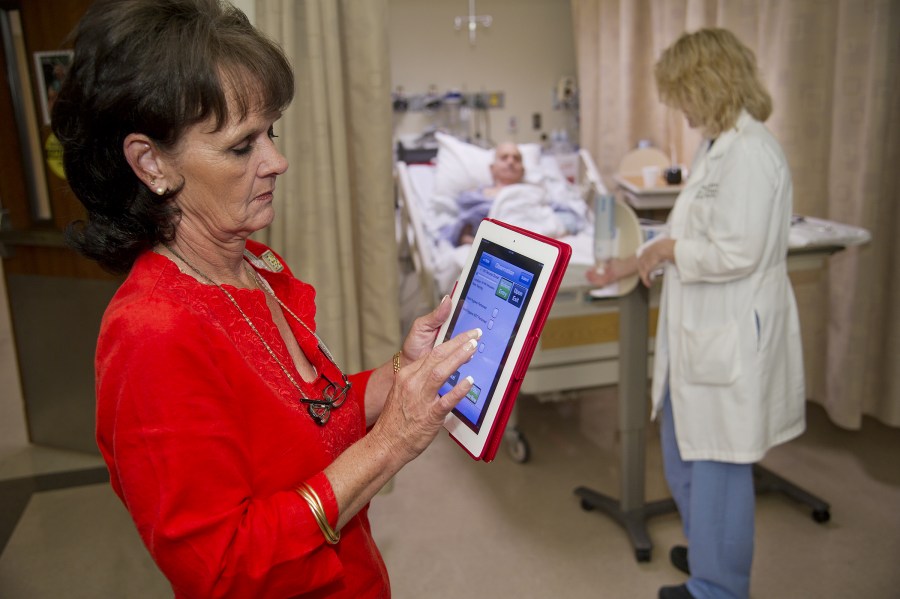
Kaye Stobaugh, R.N., MSN, left, uses the hand hygiene compliance app on an iPad to record Karen Hickey, R.N., BSN, as she washes her hands before interacting with a patient. (photo by John Russell)
VU creates app to monitor hand-washing compliance
Vanderbilt University Medical Center is serious about hand hygiene.
According to the Centers for Disease Control and Prevention, hand hygiene is the single most important intervention to prevent the spread of infection from one patient to another patient.
And now, Vanderbilt physicians, nurses and IT specialists have collaborated to create a wireless software application to more efficiently document and report hand-hygiene compliance.
The VUMC Hand Hygiene Committee, a team of physicians and nurses working together to tackle the issue, began exploring alternatives for data collection and began a collaboration with the Department of Anesthesiology’s Perioperative Informatics group. This led to the creation of a mobile application (“app”) for iPhone, iPad and iPod touch devices.
Individuals monitoring clinical areas can now send electronically recorded observations directly to a database for immediate processing. The Hand Hygiene Committee completed a successful three-month pilot using the iPod app and is planning to launch its use across VUMC over the coming year.
VUMC began an institutional hand hygiene campaign in 2003 and markedly enhanced the program in 2009. At that time, the Medical Center had a 58 percent compliance rate; today the compliance rate for all of VUMC is 91 percent. In October 2009, VUMC began a more formal process of observing staff and faculty hand hygiene compliance in all clinical areas of the Medical Center.
Trained observers began watching health care workers as they entered and exited patient rooms, documenting hand hygiene compliance using hand-written records. Because this information then had to be manually entered into a database before it could be analyzed, this system created delays in reporting of compliance.
“This process started as hand-written observations that required transcription into a database,” said Brian Rothman, M.D., medical director of Perioperative Informatics. “We now have real-time, descreet entry of data that, once uploaded, is available for reporting purposes in a more timely manner.”
Observers are trained to have a “cup of coffee” conversation — a collegial reminder — when poor individual compliance is observed. At this point, the health care worker can be counseled on proper hand hygiene. The app also allows this reminder to be captured in the data and used for education and training purposes.
“The development of this quality improvement tool is the result of a successful partnership between the Hand Hygiene Committee, Perioperative Informatics, and the Vanderbilt Center for Clinical Improvement,” said Nancye Feistritzer, MSN, R.N., associate director of Vanderbilt University Hospital.
“Claudette Fergus, a quality consultant with the Vanderbilt Center for Clinical Improvement, has been training hand hygiene observers across the VUMC campus and making sure the accountability program is properly and consistently implemented. This mobile app, combined with the proper observation protocol, has made this process much more efficient and accurate.”
“Great appreciation and recognition goes out to the entire VUMC community for the hard work put forth on improving hand hygiene,” said Thomas Talbot, M.D., MPH, VUMC chief hospital epidemiologist.
“We are clearly seeing an impact of these efforts with a comprehensive reduction in health care-associated infections in our patients. With innovations like the application created by this team, the VUMC program continues to be one of the ground-breaking hand hygiene improvement programs in the country.”













